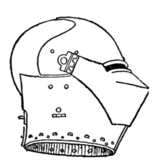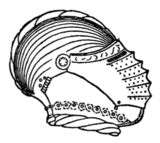called by that name in Italy. It was completed by a "buffe," or chin-piece, similar to the bavier.
 Fig. 600. |
 Fig. 601. |
 Fig. 602. |
 Fig. 603. |
 Fig. 604. |
 Fig. 605. |
During this century the "morion," really an improved "chapelle-de-fer," was much in use. It had a curved top, surmounted by a comb, and a broad, turned-up brim, and was often elaborately engraved and gilt. The "cabasset" was a similar head-piece, but had a peaked top, surmounted by a small spike turned backwards, and generally a flatter, narrower brim than the morion. These three forms of helmet were all called casques.
The barred or grilled helmet owed its introduction to tournaments with swords and clubs, which necessitated better opportunities of vision than the earlier tilting-helm afforded, sufficient though that was for encounters with the tilting-spear. The earliest form of this type of helmet will be seen in Fig. 606, which is termed a "grid-iron" helmet, developing shortly afterwards into the form of Fig. 607, which has a lattice-work visor. The former figure, the "grid-iron" helmet, is a

